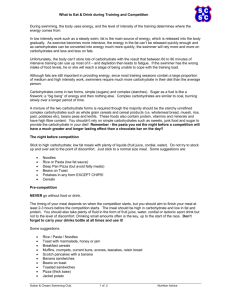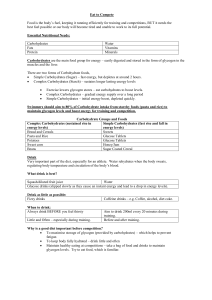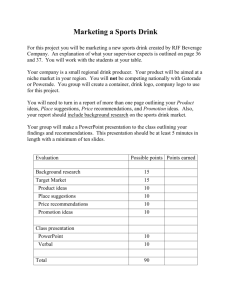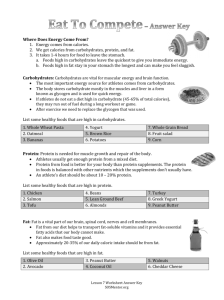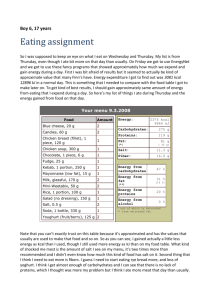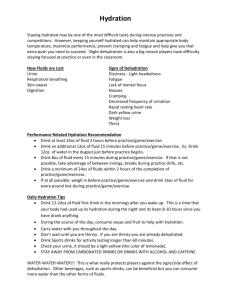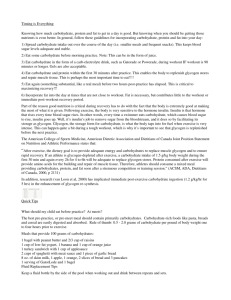Nutrition, Hydration, Dental Hygiene and Injury Management
advertisement
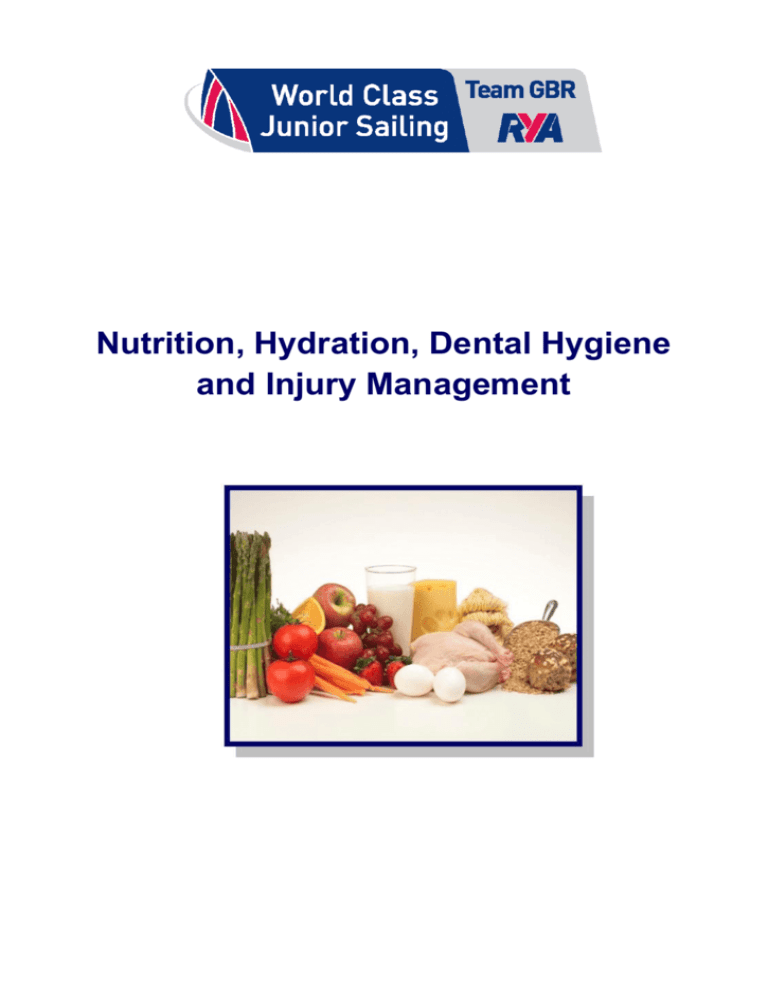
Nutrition, Hydration, Dental Hygiene and Injury Management Eating the Right Things at the Right Time Now that you are ready to begin a structured training programme, you may have some questions about proper nutrition. Good nutrition is essential for athletes for several reasons such as: Provides energy for performance Slows fatigue Speeds up recovery Increases concentration Helps your body to fight illness Helps muscle and bone growth You may have also heard that training increases the need for various nutrients such as protein. Although this may be true to some degree, it is neither necessary nor desirable for a young growing athlete to follow specialised diets or to use food supplements. Generally, home cooked food including a good balance of grains, vegetables, fruits, low fat meat and dairy products are best from a nutritional perspective. The pyramid to the left illustrates the ideal breakdown of food types for a healthy diet. Unfortunately the nature of the sport that you are in means a lot of time travelling on the road and away from home. Subsequently, home cooked food is not always available and it is easy to fall back on pre-packed snacks as a substitute. This is a real problem when you are travelling and the motorway service station is a real danger!. Unsurprisingly weak nutrition is a real danger in our sport, but a bit of knowledge and preparation goes a long way. One of the biggest misunderstandings about good nutrition is that you should totally avoid eating foods like chocolate, crisps and sweets. Although these foods lack the essential nutrients that you need as an athlete for energy, it is totally unreasonable to expect that you will never touch them. Instead you focus should be on eating the right foods at the right time. The key message here is that when you are training or racing you avoid the foods and drinks that are not going to be of any help. The next few pages will hopefully help you understand what the best choices to make are. EATING THE RIGHT THINGS AT THE RIGHT TIME! The Key Nutrients Food is a mixture of nutrients. Each nutrient has a specific job in the body but ultimately they all work together to help you feel fit and healthy. Some nutrients play a bigger role in your diet but having a good balance between them all is very important. Carbohydrate – Raw Energy! This is the fuel that your muscles prefer as energy. Your body breaks down carbohydrate into sugar before it is used as energy. If you eat carbohydrates high in sugar (simple carbohydrates) then this is converted into energy very quickly. Carbohydrates that have a high starch level (complex carbohydrates) need to be broken down into sugar by the body before they can be used as energy. For this reason simple carbohydrates are sometimes referred to as ‘quick release’ and complex carbohydrates and ‘slow release’. You diet should have a mix of simple and complex carbohydrates, too much of one type will not help you perform. Too many ‘sweet tasting’ simple carbohydrates will not help for sustaining energy and topping up your carbohydrate stores. An athlete eating too many simple carbohydrates will feel wiped out during competition and will experience the ‘sugar blues’. Protein – Repair and Recovery Protein is essential recovering from exercise. It helps to repair your muscles, speeds up the storage of carbohydrate and keeps you healthy. Growing athletes have a higher need for protein in their diet. Your protein should come from food sources only – supplements are not advisable. Some good food sources of protein are: chicken, tuna, beef, beans & pulses, low fat cheese, low fat yoghurt, milk and milkshakes. You should try and eat or drink a good food source of protein + carbohydrate immediately after a hard training session to initiate the recovery process. A really good option is a low fat milkshake such as ‘Frijj’ or ‘For Goodness Shakes’ – they are a great recover aid and taste good too! Fat – Not a diet demon!! Fat has become a bit of a misunderstood nutrient especially in athletes who follow a low-fat diet. Some fats are best to avoid such as saturated fats (found in fried foods, pasties, fatty meat etc), but others are essential for the body to absorb vitamins and fight infection. Some polyunsaturated fats are essential for health growth and have been shown to help to keep your heart healthy. These fats are found in foods such as oily fish (mackerel, tuna), olives, olive oil/spread, avocado and nuts (especially brazil, almonds and walnuts), seeds (pumpkin, sunflower, flackseed). Fat-free diets are not advisable for a growing athlete and can have negative effects on growth and performance. Understanding a Food Label Being able to understand what you food is made up of is an important aspect of an athlete’s preparation. Food labels can look confusing but they are pretty straight forward if you know what you are looking for. Per Serving / 100g Food labels are split into 2 different columns. One will tell you total content for the item and also per 100g so you can compare against others F you look at the ‘per 100g’ column, the values also represent content in %. e.g. This product contains 10% fat Energy NUTRITION Kilocalories are the same as calories What nutrients makes up the energy in food is the most important factor for athletes Energy Protein An important nutrient for recovery Protein Carbohydrate (of which are sugars) Fat Fat There are 3 main types of fat: saturates, polyunsaturates and monounsaturates. A food label will show total fat and may provide information on different types (most will always show saturated at least) Fat is very difficult to break down and use as energy so high fat foods are not a good choice when training or racing. Because fat takes a long time to break down high fat foods remain in your stomach for longer which can make you feel lethargic and slow. (of which are saturates) Fiber Sodium Salt equivalent Per Serving Contains 100g Contains 2525 kJ 605 KCal 845 kJ 205 KCal 21.6 g 61.5 g 7.2 g 20.5 g 6.6 g 2.2 g 30.0 g 10.0 g 2.4 g 0.8 g 4.8 g 0.7 g 1.4 g 1.6 g 0.2 g 0.5 g Salt or Sodium Try and limit your daily salt intake to 6g (2.4g sodium). Salt / sodium is an important addition to sports drinks when exercising in the heat. As you sweat you lose salt meaning your sodium / salt intake needs to be increased slightly when consuming fluid. Below is a basic guide that you can use to decipher some of the information on a food label: ‘LOW’ – This amount or less 3g Fat 1g Saturated Fats 2g Sugars 0.1g Sodium 0.5g Fibre ‘HIGH’ – This amount or more 20g Fat 5g Saturated Fats 10g Sugars 0.5g Sodium 3g Fibre „Per 100g‟ for a snack item such as biscuits and crisps „Per Serving‟ for meal items such as sandwiches and pasta meals Making the Right Food Choices. Breakfast: Your breakfast prior to training or competition is really important. If you want to fuel your body then you need to eat the right things. You will burn a lot of energy when training, so a slightly larger breakfast is often a good idea. A good mix of carbohydrates (simple and complex), some protein and fruit is ideal. A low fat breakfast will help avoid you feeling lethargic and slow. Some good examples: Porridge, toast with jam, orange juice and a yoghurt Cereal with milk, banana, orange juice and a yoghurt Scrambled egg, baked beans, toast and a banana Some bad examples: Bacon / sausage sandwich Fried breakfast Cereal bars NOTHING! ON WATER SNACK BARS (LOOK AT THE LABEL): Energy: look for something roughly between 120 – 170 Kcal per bar Carbohydrate: at least 20g per bar (50 / 50 split between sugars and starch) Protein: Not essential during exercise Fat: Low in fat less than 3g fat and 1g saturated per bar Generally bars that contain dried fruit (e.g. raisins, apricot berries etc.) will contain a much better source of energy than those containing chocolate. Some good examples: SIS GO Bar, Jordans superfoods bar, Nutrigrain bar, Rice Krispies Squares, Nature Valley granola bars. Some Bad examples: Twix, Mars, Snickers, Chewie bars, shop bought flapjack. IMMEDIATELY POST SAILING / TRAINING: You are looking to eat / drink a good source of protein and simple carbohydrate immediately as training finishes. This helps your body to recover and to refill the carbohydrate stores. Example combinations: Low fat milkshake + cereal bar Milk + Muller rice Tuna sandwich + some Jaffa cakes Yoghurt + 2 cereal bars Yop drink + dried fruit EVENING FOLLOWING TRAINING: Your evening meal should contain more complex (slow release) carbohydrates to aid full refill of your energy stores. A good source of food protein should also be present with it being low in fat so digestion is not effected. Try and avoid fatty desserts. If you feel the meal is lacking in protein then you can simply top it up with a glass of milk or a milkshake with dessert. BEFORE BED A milky hot chocolate before bed can be a good idea if you are feeling particularly tired. The protein in the milk helps your body repair while you are sleeping and is also thought to help improve your quality of sleep. Make sure you use hot chocolate powder that you add milk to NOT water, and brush your teeth before bed!!! Hydration A massive 2/3 of your body is made up of water! Your body needs water not only to keep cool but most of the essential bodily functions like digestion and breathing use water. Your body uses water in the same way that a car uses fuel – the harder you work the more you will use. Other things like the temperature will also speed up how fast you lose fluid. A drop in your body’s water level is called dehydration. The process of dehydration will have an effect on most of your body’s vital organs. Brain Your brain is like a sponge and is made up of 75-85% water. The brain alerts you when your fluid levels are low by making you feel thirsty. Dehydration affects mental performance; attention, concentration and short term memory are all decreased. Heart Dehydration makes the blood thicker there is less fluid to make up the plasma. The heart has to work harder to pump thicker blood around the body so you will find you have an unnaturally high heart rate when dehydrated. Lungs Your body looses fluid when your breath (you can see this as mist on a cold day when you breath out). Every day you lose the equivalent of a can of drink just by breathing! Kidneys Your kidneys control the amount of water in your body. They filter the blood for waste products that are excreted through urine. A minimum amount of water is required for the kidneys to function properly. Stomach Water is vital for digestion for the production of saliva and other digestive juices. Without enough water in your body you will not be able to convert food into energy as efficiently. Blood Your blood is made up of 75% water. Keeping this balance is essential for many functions including transporting oxygen through the blood stream. When you are dehydrated you blood becomes thicker making it much more difficult for your body to get oxygen to the working muscles. Skin Your skin is the body’s best defence against changes in temperature. You sweat to keep cool in hot weather. A drop in body fluid will lead to impaired heat regulation which can lead to serious illness. You can lose a large amount of water when exercising especially if you are on the water all day. Water or Sports Drinks? Although we are trying to top up the body’s water level during exercise, water on its own is not an ideal sports drink. The body finds it very difficult to absorb water and the result is it makes you pee a lot. A common mistake people make is that because their pee is pale in colour after drinking water they think they are well hydrated. In fact it is because the water passes through you so quickly not allowing the body to absorb it. This can also dilute your blood sugar and sodium levels. Electrolyte replacement or Sports drinks contain carbohydrate (in the form of sugar) and a small amount of sodium (salt). This balance helps the body to absorb the fluid in the drink. There are lots of these types of drinks available in the shops. If you are buying a drink, look for one that is 26% carbohydrate (2-6g per 100ml). The RYA has a sponsorship deal with Science in Sport (SIS) allowing you to get their product at 50% off. All details are on the following page. A sports drink is simply water + electrolytes. Sugar (carbohydrate) and salt (sodium) are the key electrolytes found in sports drinks. Quantities of these are specifically balanced to optimise fluid absorption. It is possible to make your own sports drink. You might like to try one of the recipes below: Recipe #1: 250 mL orange juice (or other sugarcontaining beverage) 250 mL water Pinch of salt Best mixed in warm water to dissolve salt and cooled in fridge overnight. Recipe #2: Use concentrate cordial (NOT no added sugar) like Hi-Fruits. Look on nutrition label for drink that contains 2-6g carbohydrate per 100 ml Berry flavours are normally the best options. Add water to make 1L Large pinch of salt Best mixed in warm water to dissolve salt and cooled in fridge overnight. The RYA is working with Science in Sport (SIS) (http://www.scienceinsport.com/) who are one of the leading sports nutrition companies. They have developed an extensive range of ethical and high quality products that are routinely tested to ensure they are suitable for use by competitive sportspeople. Below is a table of some of their products that the RYA recommends, with a brief description and suggested uses. Also included on the table are sale prices (all 50% of rrp). Contact your coach with as much notice as possible prior to a training camp and we will do our best to arrange delivery. Due to the weight of the items postage is not always an option. Please make cheques payable to “RYA” and write your name, address and squad on the reverse. Product Name GO Electrolyte (Hi-Cal 6%) Flavour(s) Lemon & Lime Watermelon Blackcurrant Tropical GO Electrolyte (Lo-Cal 2%) Lemon Orange Berry GO Bar Chocolate Orange Apple & Blackcurrant Chewy Banana Cherry & Vanilla Tropical Orange Tropical Blackcurrant GO Gel Description This is a ‘Hi – Calorie’ energy sports drink. It combines the use of carbohydrate and other electrolytes to aid absorption of fluid and to give you some energy. The recommended dose is 6% (60g per Litre). It is important to practise good dental hygiene if using sports drinks regularly as they are generally fairly acidic (about the same as orange juice). This is a ‘Lo – Calorie’ hydration sports drink. It has been specially developed for the RYA and cannot be purchased elsewhere. It has been specifically engineered to contain all the ingredients necessary for maximum fluid absorption with a lower carbohydrate concentration (one third the amount of the Hi-cal product). This is therefore not considered an energy drink. It is important to practise good dental hygiene if using sports drinks regularly as they are generally fairly acidic (about the same as orange juice). This is a chewy cereal based energy bar. It is an ideal snack for training and racing. Each bar contains 42g of carbohydrate. The bars contain a good balance of simple and complex carbohydrate designed to give you a mix of quick and slow release energy. Price £10 per 1.6 kg tub (makes ~26 servings at 6%) £0.40 per sachet (each sachet makes 1.0 litres of drink) £12 for a box of 24 This is an ISOTONIC gel which means it is absorbed quickly. It really is a food for use £15 for a box of during very hard training and at points of a regatta where you need quick energy 30 release. The gels will be most effective if used alongside food that is slower releasing such as the GO Bar. Don’t get confused by the ‘isotonic’ properties - they are not a substitute for fluid, they will not hydrate you. Dental Hygiene Sports drinks provide an excellent and convenient way to maintain optimum hydration levels and some of these drinks also provide energy while sailing. When consuming these products it is important to be aware of your dental hygiene in order to prevent problems with your teeth. Fruit juices (mainly citrus fruit) and fizzy drinks can be harmful to the enamel coating on your teeth mainly due to the acidity (pH) of the drink. The RYA supplied sports drinks have a similar acidity as orange juice as they contain citrus flavorings (these drinks are less acidic than fizzy drinks such as Pepsi or Coke.) When you exercise you increase the potential for enamel damage for 2 reasons: 1) When you exercise your saliva production is reduced. A dry mouth increases erosion. 2) When you sweat you lose fluid that you need to replace so you end up drinking more than normal. Sports drinks give you a big advantage in maintaining hydration and providing energy. Following the tips below can help to minimize any effects on your teeth when using sports drinks. Don’t hold or 'swish' sports drinks around the mouth Try to drink chilled soft drinks and sports drinks as cooler temperatures have been shown as less likely to encourage tooth erosion Try to follow consumption of a sports drink with water as it helps with saliva flow and helps wash the sugars and acids from such drinks away. Chew sugar free gum to increase saliva flow in your mouth. Increased saliva flow can assist with neutralizing acid from bacteria and protect teeth. Make sure your brush your teeth at least twice a day Injury Management As athletes you are training and competing at a high level and this carries an increased risk of injury. Proper care in the first day or two after injury can reduce the time you have to stop training and sailing. Should you suffer a sprain, strain, pull, tear or other muscle or joint injury, treat it with P.R.I.C.E. – Protect Rest, Ice, Compression and Elevation. IMPORTANT: This is a treatment used as a first response treatment for acute injuries. It is always advisable for any injury to be checked out by a medical professional to get a proper diagnosis. PRICE (P) Protect Protect the injury from further damage. Don’t do anything that causes you pain. E.g. If it is too painful to put weight through the injury you may need crutches. Or if it’s an upper limb injury a sling may be required. The main aim is to off-load the injury. (R) Rest If you feel pain from a new injury, stop the activity immediately. You need to rest to prevent any further damage, this means no sport, less walking, lifts should be used instead of stairs and wearing practical footwear. This allows the healing process to commence. Resting straight away will often reduce the extent of the injury and allow you to return to sport sooner. (I) Ice Apply ice immediately and continue during the first 24 – 72 hours following injury to reduce swelling. Crushed or cubed ice works best as it will mould to the body shape. For ankles you should submerge the whole joint in a bucket consisting of ice and water. Initially, ice at least once an hour. Never leave ice on longer than 20 minutes, 15 minutes is ideal. Longer than this and the body thinks it is being frostbitten and sends blood to the area, which defeats the purpose on icing in the first place! You should get slight numbness at the injury site after about 4 minutes. If there is any further swelling after 72 hours and/ or pain, continue to ice for up to 10 days. Think about the ice as a medication from the doctor. You have to take the whole prescription for 10 days, 2-3 times per day and finish it otherwise it will not have the desired effect. (C) Compression Helps limit swelling which would otherwise delay healing time. Keep a compression dressing around the body part. This could be a towel, bandage, tubigrip, elasticated bandage, neoprene supports. It should be rapped snugly but not to the point of numbness or discomfort. (E) Elevation Elevate the injured part above the level of the heart as much as possible for 72hrs following injury, this helps to drain excess fluid from the injured area. Use pillows to elevate the injured area, even when you’re in bed. * Any issues regarding PRICE please contact your physiotherapist or physiologist.
